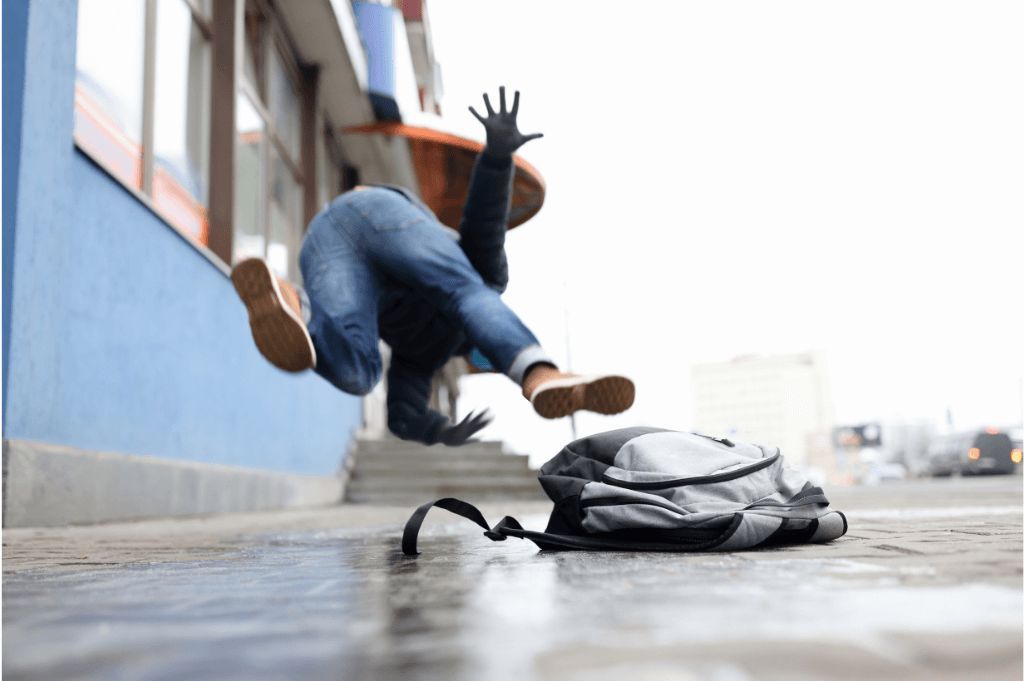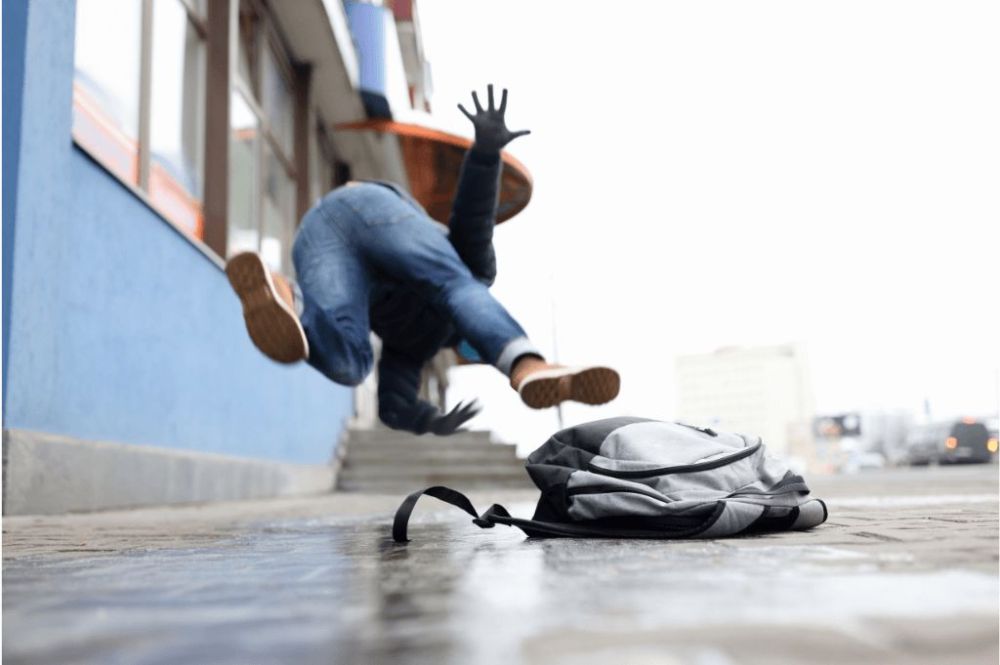Proving Negligence in Michigan Slip-and-Fall Cases


Slip-and-fall accidents can cause serious injuries. According to the National Floor Safety Institute, falls account for over eight million emergency room visits yearly. Whether you tripped over something at the grocery store or slipped on a patch of black ice, a slip-and-fall accident can rack up medical bills. If this has happened to you, you deserve compensation from the responsible party. You may be able to recover damages under a legal theory called “premises liability.” This is a form of negligence in Michigan law. A recent Michigan Supreme Court ruling improves your chances of proving that a property owner or business owner was at fault. Learn more about how negligence works in Michigan slip-and-fall cases and how Matz Injury Law can help you get back on your feet.
Common Causes of Slip-and-Fall Accidents in Michigan
Slip-and-fall accidents may occur due to dangerous conditions on a surface that can cause a person to slip or trip. Examples might include:
- Broken tiles or other flooring material
- Torn carpeting
- Damaged or defective steps or stairs
- Missing or broken handrails
- Uneven floors
- Wet floors due to spills, leaks, or tracked-in rain or snow
- Slippery floors due to excessive wax or poor maintenance
- Sudden changes in texture, such as going from a rough surface to a smooth one
- Inadequate lighting
- Potholes or other damage in a parking lot or along a walkway
- Objects obstructing a walkway or path
What is Negligence?
Many personal injury cases are based on a legal theory known as “negligence.” Premises liability is a type of negligence claim. To prove that a defendant in a personal injury claim was negligent, a plaintiff must establish four elements:
- The defendant owed a duty of care to the plaintiff.
- The defendant breached that duty.
- This breach caused the plaintiff’s injuries.
- The plaintiff suffered damages as a result.
Premises liability law states that a property owner owes a legal duty to maintain their premises in a safe condition or to warn people about known hazards. A property owner could be legally negligent in a premises liability case if:
- They created or caused a hazardous condition, such as a spill, on their premises.
- They knew about a hazardous condition, such as a pothole or a broken stair, but failed to repair it.
- They knew about dangerous conditions on the premises, like black ice, but failed to warn people.
The plaintiff must prove that their injuries resulted from the hazardous condition. For example, if they suffered broken bones, they must show that the fall directly caused that injury. They must also prove they suffered damages, such as lost wages or medical bills.
Who is Liable in a Michigan Slip-and-Fall Accident?
Liability for slip-and-fall injuries depends, in part, on where the accident occurred. The property owner could be liable for an injured person’s damages, or liability could fall on someone who occupies the property, such as a business that leases a building.
Commercial Property
If a slip-and-fall accident occurred at a business, such as a store or office, liability may depend on two main factors:
- Did the accident occur within a leased space or in a common area that several tenants might share? A tenant might be liable for injuries inside a store, while a property owner might be liable for injuries in a parking lot.
- Who is responsible for maintenance items in a lease agreement? Whoever is responsible for maintaining a particular area is most likely liable for injuries caused by dangerous conditions there.
Residential Property
A homeowner is liable for injuries in slip-and-fall accidents on the property where they live. If an injury occurs in a rented home or apartment, the tenant or the property owner could be liable, depending on many of the same factors mentioned above for commercial properties.
Government Property
The government’s duty to maintain public premises in a safe condition depends on laws in each state. An injured person might be able to bring a premises liability claim after a slip-and-fall accident on government property in some situations. Michigan law states explicitly that government agencies are liable for injuries resulting from broken pavement on many public roads.
Examples of Negligence in Slip-and-Fall Cases
The following cases are examples of scenarios in which a property owner or business owner could be liable to an injured person:
- A grocery store failed to repair a leaky freezer in its frozen food section, resulting in a wet floor.
- An apartment management company neglected to fix a broken handrail on a set of stairs.
- A retail store failed to warn customers about black ice in an area of its parking lot.
- A homeowner did not warn guests about a hole in their backyard.
How to Prove Negligence in a Michigan Slip-and-Fall Accident
In order to prove that a defendant was negligent in a Michigan premises liability case, a plaintiff must establish the four elements of a negligence claim described above. They must also demonstrate that they exercised reasonable care and used the property correctly. An injured person might be unable to recover the full damages they suffered if they behaved in an unsafe manner.
The circumstances in which an injured person was on the premises could also factor into a premises liability claim. A property owner has the highest duty of care to a person with permission to be on their premises, also known as an “invitee.” For business owners, this includes customers, employees, and others who have business-related reasons to be there. This does not mean that trespassers cannot make a claim for injuries under any circumstances, but they might have a more difficult time proving their case.
Michigan law gives injured persons a limited time to file a lawsuit. The time limit, or statute of limitations, is three years from the date of the slip-and-fall accident. Since a lawsuit is often a last resort after insurance claims are unsuccessful, it is important to begin the claims process with the property owner’s insurance company as soon as possible.
2023 Change in Slip-and-Fall Laws: The End of Michigan’s Open and Obvious Defense
On July 28, 2023, the Michigan Supreme Court issued a ruling that substantially changed the state’s premises liability laws. State law previously followed the “open and obvious” rule, which held that property owners are not liable for injuries caused by dangerous conditions on their premises that are clearly visible. The court reduced the effect of the open and obvious rule but did not abolish it.
The new rule for premises liability claims involving open and obvious dangers considers whether to split the total fault between the parties. It asks whether the injured person should have seen the hazardous condition and the extent to which the property owner took reasonable care to protect people from it.
A claim for a slip-and-fall accident on a surface that was slippery due to ice could have a very different outcome under the new rule. In the past, Michigan’s characteristically cold winter weather might have led to the conclusion that property owners are not responsible for many slip-and-fall injuries caused by ice since people should be aware of that particular danger. Now, a premises liability claim might involve questions like:
- Where was the ice located, and how visible was it?
- Did the property owner warn invitees about icy conditions?
- Did they take any steps to protect invitees, such as by plowing or salting the premises?
Judges and juries will decide how much fault belongs to the injured person and the property owner. Under Michigan’s comparative negligence law, a plaintiff cannot recover any damages if their share of the fault is 51% or more. Now, more plaintiffs will be able to have their day in court thanks to the Michigan Supreme Court, and personal injury attorneys have the opportunity to convince juries that their clients deserve compensation.
How Are Slip-and-Fall Settlements Calculated?
Two main types of damages are available in Michigan slip-and-fall cases. Economic damages compensate injured persons for direct losses caused by the defendant’s negligence, such as:
- Medical bills
- Lost wages
- Cost of future medical treatment
- Lost earning capacity
- Funeral expenses in wrongful death cases
Not all damages are so easily quantifiable. Non-economic damages attempt to compensate a plaintiff for the impact of the accident and their injuries on their quality of life. This might include:
- Pain and suffering
- Emotional anguish;
- Loss of enjoyment of life;
- Disfigurement
- Loss of consortium, which is a claim that the spouse or partner of an injured person can make for the loss of their support, companionship, and intimacy.
Establishing economic damages typically begins with adding up all of a plaintiff’s expenses and other direct losses. Future economic damages are often based on how much a plaintiff has already incurred in damages and projections of how much it will continue to cost.
Non-economic damages are much more subjective. Personal injury lawyers often use two methods to calculate those amounts:
- Multiplier method: A plaintiff’s pain and suffering and other non-economic damages are calculated by multiplying the total amount of economic damages by a number ranging from 1.5 to 5.
- Daily rate method: For relatively short-term injuries, it can be effective to determine a per diem rate of non-economic damages. This method looks at the total number of days that a plaintiff experienced pain and suffering. Suppose this was a total of 300 days. The plaintiff makes $50,000 per year. Assuming they can work five days per week for fifty weeks out of the year, they earn $200 per day. Their total non-economic damage amount could be that daily rate over the time they suffered from their injuries, or $60,000.
How Comparative Negligence Works in Michigan Slip-and-Fall Cases
Michigan uses a “comparative negligence” system in personal injury cases. In a legal claim for negligence, a judge or jury would determine how much fault for the accident is shared between the plaintiff and the defendant, if any. If the plaintiff is partly at fault, their final damage award would be reduced by that percentage. If the plaintiff is at least 51% at fault, their damage award would be zero.
Suppose, for example, that a jury finds that a defendant is liable for a plaintiff’s damages after a slip-and-fall accident, but the plaintiff was partly at fault for the accident. The defendant might have failed to repair a known hazardous condition, but the plaintiff did not exercise reasonable care to avoid an accident. The jury determines that the plaintiff’s total damages are $250,000.
- If the plaintiff was 10% at fault, the jury would reduce the damage award by that percentage, or $25,000.
- If the plaintiff was 25% at fault, the jury would reduce the award by one-fourth, or $62,500.
- If the plaintiff was 50% at fault, they would receive half the award amount.
- If the plaintiff was 51% at fault, the damage award would be $0.
How a Michigan Slip-and-Fall Accident Lawyer Can Help You
Michigan slip-and-fall lawyers have extensive experience preparing claims for damages. They know all the tricks that insurance companies and defense attorneys might use to minimize the amount they have to pay, and they know how to get around those tricks. They know how to navigate the Michigan court system and prepare a strong case for you. An experienced Michigan personal injury law firm can help you with:
- Communicating with medical providers and experts to build evidence of your injuries
- Collecting witness statements
- Calculating damages
- Preparing an insurance claim or slip-and-fall lawsuit
- Meeting deadlines for filing
- Negotiating with lawyers and insurance companies
- Representing you in court if necessary
Why Our Clients Choose Matz Injury Law
Matz Injury Law charges a 22% contingency fee, while most firms charge 33%. You do not have to pay your lawyer anything until they recover money for you, and you can keep more money with Matz.
The legal team at Matz takes pride in spending as much time as necessary gathering evidence and exploring all possible avenues of recovery. You are never just another number/file to us. We care about each of our clients, and you will always be represented by a Matz, not just an associate assigned to handle slip-and-fall claims.
Testimonials from Satisfied Clients
“I cannot speak highly enough of Steve and his team! Everyone is so friendly and professional. Steve always kept me in the loop during the whole process and I tried to do the same. I love that Steve is such an honest person, he’s not going to sugar coat anything but he’s also not rude about it either. Whenever I needed to talk to Steve he was always there and still always will be, I know I can always trust him and if I need anything he will help me out. I seriously couldn’t have asked for a better lawyer to share this journey with, if I had to do it all over again I wouldn’t change my lawyer and if I ever need a lawyer again he will always be my first choice.” -Kristina K.
“We were very pleased with our experience with Steve Matz, he’s personable, knowledgeable, timely in returning calls, explains the process well. And his fees are reasonable. When ever I called the office a real person answers the phone, no recordings. His staff is kind and helpful. We certainly would call on him again if needed.” -Bill and Sandra M.
We’ll Help You Get Back on Your Feet
The Michigan slip-and-fall attorneys at Matz Injury Law have decades of experience helping people who have suffered injuries because of hazardous conditions on other people’s premises. They can identify who is at fault for your injuries and help you recover the compensation you deserve. Contact the firm today at 1-866-22Not33 or through the online contact form.




